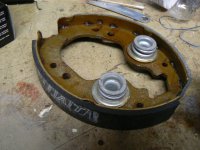Put new rear shoes in and bled all round. Is there a secret way of adjusting the handbrke to get it to function.....? I've adjusted the cable but it now binds and still not very effective...
cheers
RRR
I guess your shoes looked like these ones?

If they don't then I've just wasted my time on ever thing I'm about to write here!
Those are spares left over from my 1992 Panda Parade. The spring "thingies" on the shoes are the self adjusters. As you'll know they fit over pegs on the backplates with a small amount of clearance. When you press down on the brake pedal the cylinder pistons force the shoes out until they contact the drum. The self adjuster moves with the shoe until the clearance on the peg is taken up (there's not much clearance to take up) once the clearance is taken up the shoe slides through the friction washers whilst the adjuster is restrained by the peg. when you let your foot off the pedal the return springs pull the linings away from the drum. But because of the springs on the friction washers which make the friction washers grip the lining, the shoe can only retract until the clearance between the peg and adjuster is used up thus maintaining a close running clearance between the shoes/linings and the drum. As the lining wears the shoe slides further out through the friction washers and so the close clearance between lining and drum is maintained as the lining wears.
That's how it's meant to work anyway. I found that it didn't work very well and the friction washers were quite poor at gripping the shoe thus failing to compensate properly for lining wear. Genuine Fiat shoes and adjusters, as above, tended to work best. There's more on this in a minute so read on.
If you've understood this you'll notice the hand brake levers on the shoes, unlike most other designs, have nothing at all to do with the self adjusters? The lever on the trailing shoe is pivoted at the top of the trailing shoe and there is a fixed length bar which fits between this lever on the trailing shoe and the leading shoe. When you pull up the handbrake in the vehicle, the cable pulls on the bottom of the lever on the trailing shoe which pivots on the top of that trailing shoe whilst also pushing the fixed length bar forward against the leading shoe so forcing the shoes apart and gripping the drum.
Interestingly this is one of the very few designs where the hand brake travel will increase as the shoes wear because the reaction bar between the shoe is not the self adjuster and is fixed length.
As the linings wear down and you have to tighten the hand brake cables to compensate so the lever/reaction bar relationship goes more and more "over centre" - for want of a better way to describe it - so the mechanical advantage of the leverage is reduced the more the linings wear and the handbrake efficiency decreases. Unfortunately any wear on the fulcrum pin at the top of the trailing shoe or on the fixed length bar between the shoes will increase this effect.
I struggled with Felicity's (the purple Panda in my avatar picture) rear brakes for most of the time we owned her (around 20 years) The self adjusters rarely worked for more than a year after fitting new ones (back then you could buy the friction washers and springs separately). But, after much experimenting and in the later years of owning her when her value had reduced to pretty much nothing, I welded new metal to the ends of the fixed bar and filed back into shape so that the bar was actually slightly longer than it had been when new. This forced the lever (which pivots on the trailing shoe) to adopt a resting position further back so increasing the angle of attack on the fixed bar and so increasing the leverage. Our local MOT tester said he'd never tested a Panda with such a good handbrake.
You can "cheat" if your self adjusters are not "behaving" (ie. failing to grip the shoes properly) With most drum rear brakes it's very important to always have some slack in the cables when the handbrake is in the off (running) position so that the self adjusters can pick up on the ratcheting mechanism which makes them work (usually integral to the bar between the two shoes, but not on our early Pandas) Tightening the handbrake cables on these early model Pandas will, as on most cars, bring the shoes out nearer the drums so reducing pedal travel. The big difference is that, as there's no self adjusting mechanism linked to the handbrake, you can do this to "adjust" the rear brakes without fear of defeating the self adjusting mechanism. However if there is any substantial wear in the pivot pin or the holes in the shoe or lever or wear on the ends of the fixed length bar or where it fits the lever, and usually, in my experience, there's a combination of wear at all these points, handbrake performance will suffer.
I hope that wasn't too confusing? Please feel free to ask questions if you like.


